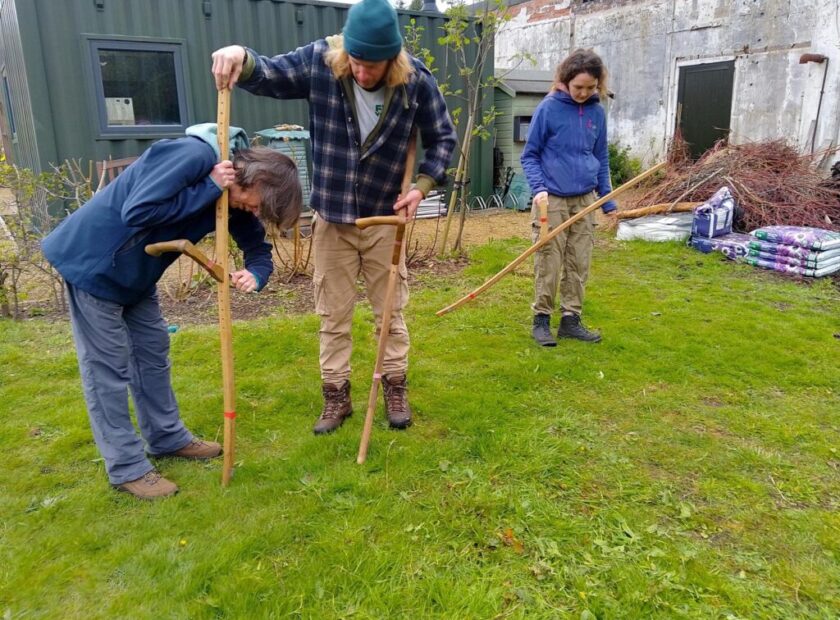Learning to scythe at Ravenscraig Walled Garden

At Ravenscraig Walled Garden, we care for a community orchard with more than 60 fruit trees. These trees include Scottish heritage apples, pears, mirabelles and cobnuts.
In the absence of a couple of sheep, in previous years we have kept grass in check with petrol mowers and strimmers. This keeps the space accessible, and reduces competition with the trees from the grass. Reducing competition is especially important whilst fruit trees are becoming established.
However, the site is tricky to mow with a conventional mower. The ground is sloped and uneven and the young fruit trees still have branches close to the ground. This means mowing can be a hazard both to the person doing the mowing and to the trees. Not to mention a very strenuous effort.
We decided to investigate scything as a possible alternative method to cut the grass in the orchard, and other grass areas we are responsible for at the walled garden.
Scything has several advantages. For one it is much quieter, reducing the amount of noise pollution compared to petrol tools. It is also, obviously, not reliant on fossil fuels, so reduces our climate impact.
It’s suggested that scything is also less disruptive to wildlife, due to the human scale and speed, and reduced frequency, of cutting. Good grassland management can lead to an increased diversity of flower species, which benefits pollinators, and wider biodiversity. Effectively managed grasslands also sequester carbon. This is explained in more detail in Plantlife’s report Grassland as a Carbon Store (pdf).
We invited scything tutor Rob Brodie to teach staff and volunteers the basics in a one-day workshop. First we learned about the different types of blades, how to set up the scythe depending on your height and build and the movements required to get a good cut.
We learned that there are different blades for different jobs – some are longer and faster for open grassland, some are more robust and suitable for working through brambles and woodier weeds.
Once we knew the basics, we went off to practice in the orchard!
I was surprised how easy it was to adapt to the slope and work around the trees. With some advice from Rob we honed our technique. One aspect of scything that particularly suits a community garden is it is something that you can do as a group. No ear defenders are required so you can talk. And by working together you can cover a surprising amount of ground quite quickly. A certain amount of mobility is required but scything technique is more important than physical strength.
Once you have got the hang of the motion and set up your scythe correctly, scything is a mindful and satisfying pursuit. We listened to the rhythm of the grass being cut, and the birds singing. We also took time to notice the different species of wildflower present amongst the grasses and saw bees and hoverflies among the apple blossom.
In the afternoon, we covered how to sharpen and ‘peen’ the scythe blade. Peening involves hammering the blade, which it is quite noisy, but it is essential to ensure a good cut.
By the end of the day, all participants were confident in using a scythe. We hope we will incorporate this into how we manage our green spaces for people, nature and the climate. There is certainly a lot more for us to learn about the impacts of scything on the health of the fruit trees and ecosystems in the orchard.
If you are interested in finding out more about scything the Scythe Association has information and regular events.
Esme Armour, Greener Kirkcaldy
|